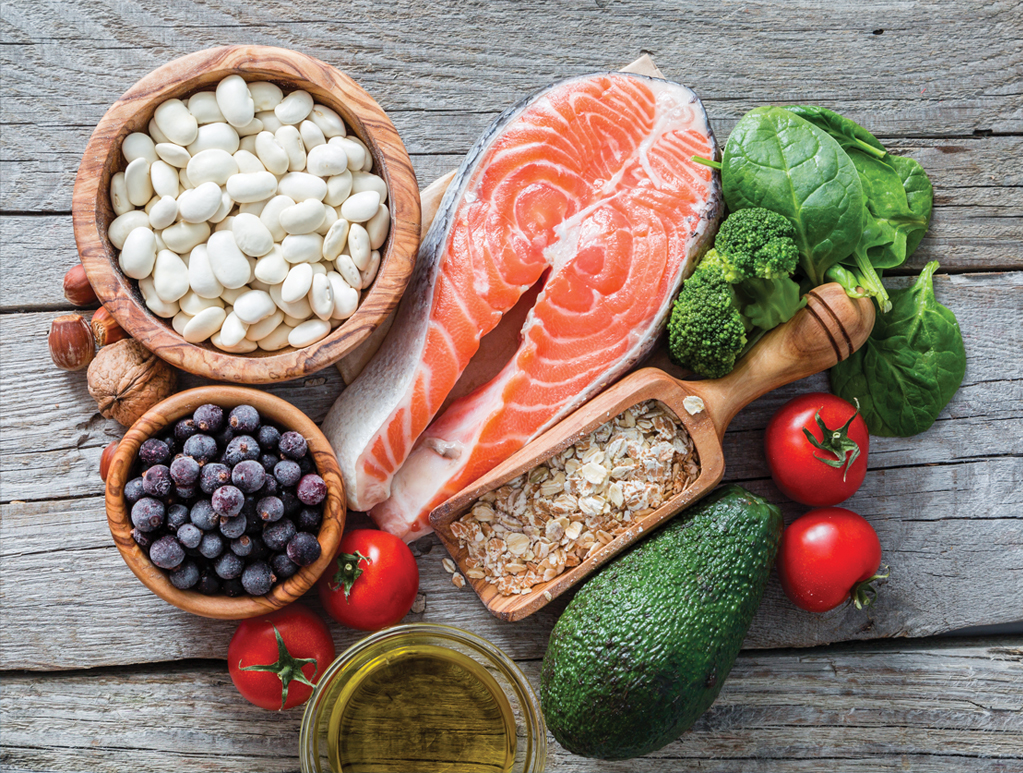Making smart food choices is one way to keep diabetes in check. This article covers a range of foods that helps lower the risk of complications from the disease. Best of all, they are easily found in supermarkets.

Every time you eat, your body converts what you consume into glucose. This passes through the walls of the intestines into the blood, causing your blood sugar to rise. The pancreas responds by releasing insulin to move sugar from the blood into the cells to be used as energy, thus restoring your blood sugar to normal levels.
Diabetes develops when the body does not make enough insulin, or the cells do not respond to the insulin, causing blood sugar to build up in the bloodstream. Long-term elevated blood sugar levels can lead to heart disease, stroke, kidney failure, nerve damage, and blindness.
According to a report in The Straits Times on 7 March 2018, an estimated 430,000 Singaporeans aged 18–69 are affected by pre-diabetes. If nothing is done, one in three with pre-diabetes is likely to develop type 2 diabetes within eight years.
Type 1 diabetes accounts for 5–10% of all cases of the disease. It develops when the pancreas makes little or no insulin. It can be genetic or caused by stress, such as a viral infection. Type 2 diabetes usually begins with insulin resistance; it is usually related to being overweight and physically inactive. If diagnosed early, type 2 diabetes can be managed with weight loss, proper eating habits, and exercise.
Managing diabetes is about adopting a healthier lifestyle by making small changes one at a time. Start by creating a healthy eating plan with foods that are easily available.
WATER
Drink water throughout the day. Thirst is one of the main symptoms of diabetes because blood glucose that is higher than normal can deplete fluids. Increase your water intake, especially if you are exercising.
CAFFEINATED DRINKS
Coffee or tea with no milk or sugar can speed up your metabolism and may lower the blood sugar and decrease your weight.
GRAINS AND BREADS
Oatmeal is high in carbohydrates but contains soluble fibre that may help delay the rise in blood glucose. Choose steel-cut or old-fashioned oats. Check for added salt and sugar in the quick cooking and instant varieties.
Choose wholemeal or multigrain bread; they provide complex carbohydrates for sustained energy.
Brown rice and other complex carbohydrates take longer to digest, which helps you stay full for longer and keeps your blood sugar levels within normal ranges.
VEGETABLES
Asparagus is low in carbohydrates and high in the antioxidant glutathione, which plays a key role in easing the effects of diabetes.
Avocados are low in carbohydrates and have a heart-healthy monounsaturated fat content.
Broccoli contains the chemical sulforaphane, which was found to reverse vascular damage to blood vessels caused by diabetes in a study by the University of Warwick in England in 2008.
Carrots, too, are low in carbohydrates. They are also rich in beta-carotene, which can help to lower the risk of type 2 diabetes, according to a study by the Stanford University School of Medicine.
Red bell peppers deliver a healthy dose of lycopene, which promotes good health and reduces risk of heart disease and diabetes.
Leafy greens, such as spinach, have been shown to reduce risk of type 2 diabetes by 14%, according to the American Diabetes Association (ADA), which singled out a study that determined eating more fruits and veggies lowered the risk of diabetes.
BEANS
Beans — black, kidney, garbanzo, white, pinto — have been shown to result in better blood sugar control (for both blood glucose and HbA1c) and lowered blood pressure.
FRUITS
Blueberries have a high fibre content that may help keep blood sugar levels steady. They contain anthocyanin, an antioxidant linked to lowered risk of type 2 diabetes. Researchers found that people who ate two or more servings of blueberries weekly reduced their risk of developing type 2 diabetes by 23%, even after adjusting for age, weight and lifestyle factors.
Fresh cranberries — with their abundant phytonutrients, including anthocyanin — may be especially beneficial in a meal plan for diabetics.
Watermelon is a good source of fibre, which helps the body flush out toxins and slows the release of glucose into the bloodstream.
FISH
Fish — salmon, mackerel, herring, lake trout, sardines, halibut, albacore tuna — is a good source of omega-3 fatty acids, which may decrease insulin resistance in people with diabetes.
NUTS AND SEEDS
Flaxseed is possibly effective for lowering HbA1c in type 2 diabetics.
Quinoa contains all nine essential amino acids (those that the body cannot make), making it a complete protein. Like other wholegrain and highfibre foods, quinoa can help prevent blood sugar spikes and stave off hunger.
Nuts can improve blood sugar control in type 2 diabetes, but should be eaten in moderation. As a serving guide, this means 10 peanuts, six cashews, six almonds or 12 pistachios. Avoid varieties that are salted, sugared, honeyed, or chocolate-covered, because these add calories, carbohydrates, and salt.
SOY PRODUCTS
Foods rich in soy bioactive compounds called isoflavones can lower diabetes and heart disease risk. Eating soy foods has been shown to lower cholesterol, decrease blood glucose levels, and improve glucose tolerance in people with diabetes.
CHECKLIST FOR MANAGING DIABETES
1. Eat healthy
Choose healthy foods, be strict about portion sizes, and eat at regular times.
2. Exercise
Stay fit with an activity you can commit to, be it walking or swimming.
3. Monitor
Monitor your blood glucose daily.
4. Take your medication
Understand how medications work, and when to take them.
5. Be prepared
When a high- or low glucose episode occurs, be prepared to make quick decisions about food, activity or medications.
6. Self-care
Take steps to reduce risk of complications. Start by quitting smoking and getting regular eye exam.







